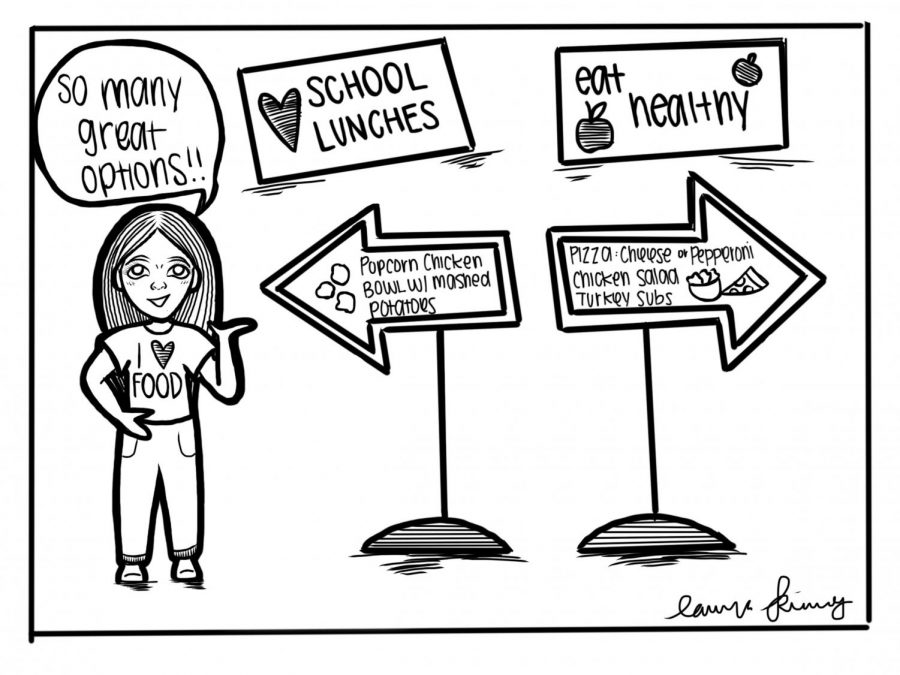Opinion: School Lunches – What’s on Your Tray?
March 15, 2018
Breakfast may be the most important meal of the day, but Platteview High School
students rely on a meal at lunch to sustain their brain power until the final bell of the school day. Some students bring a lunch from home, but many partake in Platteview’s hot lunch program. Many of Platteview’s students have positive opinions on the hot lunch program; however, there is a consistent murmur of discontent with lunches at Platteview. We, the editorial team of The Charioteer, decided to investigate and report on our school lunches, how they impact us as students, and how such information can give a clearer perspective of the issue – to ask: What’s the Value of School Lunch?
For $2.85 a day, a Platteview High School student can enjoy a hot lunch. This price is fairly comparable to surrounding school districts. Syracuse matches with $2.85. DC West charges $2.65. Bennington students walk away with a lunch for $2.65, as well. But our question of “What’s the Value of School Lunch?” goes further than the financial value. We wanted to look at not only the quantity and quality of each tray, but we wanted to know what our student body thought of the culture of school lunch. What personal connection, suggestions, or appreciations did they harbor for their daily 30 minute relief from their classes.
When we asked Platteview students about school lunch, we collected a mix of emotions and responses. Mostly, though, they had some suggestions of their own to further improve the overall quality of provided meals. Junior, Alyssa Riha, said she is very appreciative of the lunch staff’s flexibility to accommodate her vegetarian diet. “I personally think the lunch staff goes the extra mile when there aren’t meatless options available. They always [offer alternative lunches] to me even if [the alternative] isn’t on the menu,” said Riha. “I think having [prepared] meatless options would make it easier for [the lunch staff].”
Sophomore Zane Woods agrees there could be more variety for students with diet restrictions but understands how it may be difficult to include extra options. “We are a smaller school, so I could see why [we currently don’t have as many choices],” said Woods.
Senior Madi McKewon suggests the school provides a survey to gain a better understanding of the types of meals students would prefer. “I know there are [multiple students] who can’t eat the lunch provided because of their preferences or their diet. Maybe a survey would give the [lunch staff] an opportunity to plan meals according to the students’ responses.”
When we first set out to investigate school lunches, we anticipated hearing reports of terrible experiences, of complaints and horror stories. But that simply wasn’t the case. Instead, even though there was a hum of distaste of the food, Platteview students held high level of respect for the lunch personnel and those that helped the students through the lunch line each day.
At the Platteview Junior High, on the other hand, students and staff alike had make some varying points. Ryan Grell, an eighth grade student, said that the lunches are “usually pretty good,” and “always [have] some sort of vegetable.” However, Jayla Lee said the lunches sometimes aren’t cooked all the way. Jacob Zimmerman said that he ate lunch only when he “got what he liked.” The junior high health and physical education teacher, Mrs. Elder, said that she felt that the lunches “could be healthier, [use] local products, [and have] more healthy options… [including] less processed [foods].” Especially as “nutrition should be [a student’s] main fuel.” Food Service Director Kim Jamber creates the menus, and the food is supplied by Reinhart FoodService. Robin Hill, a member of the lunch staff at the junior high, said that there is “always a non-meat item,” and a “beginning of the year allergy request” from the students.
Regardless of lunch room politics, eating healthy snacks during the day, especially for students, is useful for brain energy and focus during the school day. For students with vegetarian and vegan diets, this is even more inconvenient because they do not have options in the cafeteria. For students with restricted diets, allergies, and religious beliefs that affect their eating style this proposes a lot of issues. According to the international journal of behavioral nutrition and physical activity “A study of 55 high schools revealed that school environments do not always foster healthful eating practices consistent with national dietary guidelines.”
Because of the importance of eating healthy and gaining needed energy throughout the day, countries from around the world have taken a deep seeded interest in their school lunch programs. And while each country takes a different approach to school lunches, lunches from around the world can look drastically different from one another. Someone from another country like Japan might have vegetables, soups, and rice. Most of their food is locally grown almost never frozen. One of the common dishes they have is miso soup, made up of seaweed, soy bean paste, soft tofu, and scallion greens. A lot of Asian countries share the same blueprint to their lunches. Like in South Korea the basic and normal lunch is Dubu chigae, zucchini, tofu, and spicy red pepper flakes. The Huffington Post outlines in more detail lunches from aournd hte world (https://www.huffingtonpost.com/2015/02/25/school-lunches-around-the-world_n_6746164.html), which proved to be quite insightful. One might say that the lunches in these countries are pretty diverse, but it also begs the question: are school lunches in America and here at Platteview meeting their students’ needs, tastes, and cultures?
But we would like to hear what you have to say about school lunches. Please post your comments and pictures below on the topic.

Alyssa Riha • Mar 24, 2018 at 10:33 pm
This is a really well written article! The financial, dietary, and cultural aspects you provided left me with a well-rounded understanding of your purpose in writing this article. Well done!